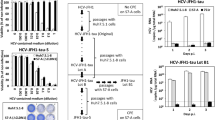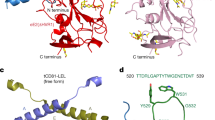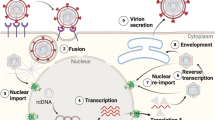Abstract
Hepatitis C virus (HCV) is a leading cause of cirrhosis and liver cancer worldwide. A better understanding of the viral life cycle, including the mechanisms of entry into host cells, is needed to identify novel therapeutic targets. Although HCV entry requires the CD81 co-receptor, and other host molecules have been implicated, at least one factor critical to this process remains unknown (reviewed in refs 1–3). Using an iterative expression cloning approach we identified claudin-1 (CLDN1), a tight junction component that is highly expressed in the liver4, as essential for HCV entry. CLDN1 is required for HCV infection of human hepatoma cell lines and is the first factor to confer susceptibility to HCV when ectopically expressed in non-hepatic cells. Discrete residues within the first extracellular loop (EL1) of CLDN1, but not protein interaction motifs in intracellular domains, are critical for HCV entry. Moreover, antibodies directed against an epitope inserted in the CLDN1 EL1 block HCV infection. The kinetics of this inhibition indicate that CLDN1 acts late in the entry process, after virus binding and interaction with the HCV co-receptor CD81. With CLDN1 we have identified a novel key factor for HCV entry and a new target for antiviral drug development.
This is a preview of subscription content, access via your institution
Access options
Subscribe to this journal
Receive 51 print issues and online access
$199.00 per year
only $3.90 per issue
Buy this article
- Purchase on Springer Link
- Instant access to full article PDF
Prices may be subject to local taxes which are calculated during checkout





Similar content being viewed by others
Change history
12 April 2007
In the AOP version of this Letter, the label 'K48V' in Fig. 4h should have read 'K48E'. This figure has now been corrected for both print and online publication on 12 April 2007. The mistake did not affect any results.
References
Bartosch, B. & Cosset, F. L. Cell entry of hepatitis C virus. Virology 348, 1–12 (2006)
Cocquerel, L., Voisset, C. & Dubuisson, J. Hepatitis C virus entry: potential receptors and their biological functions. J. Gen. Virol. 87, 1075–1084 (2006)
Barth, H., Liang, T. J. & Baumert, T. F. Hepatitis C virus entry: molecular biology and clinical implications. Hepatology 44, 527–535 (2006)
Furuse, M., Fujita, K., Hiiragi, T., Fujimoto, K. & Tsukita, S. Claudin-1 and -2: novel integral membrane proteins localizing at tight junctions with no sequence similarity to occludin. J. Cell Biol. 141, 1539–1550 (1998)
Hsu, M. et al. Hepatitis C virus glycoproteins mediate pH-dependent cell entry of pseudotyped retroviral particles. Proc. Natl Acad. Sci. USA 100, 7271–7276 (2003)
Bartosch, B. et al. Cell entry of hepatitis C virus requires a set of co-receptors that include the CD81 tetraspanin and the SR-B1 scavenger receptor. J. Biol. Chem. 278, 41624–41630 (2003)
Meertens, L., Bertaux, C. & Dragic, T. Hepatitis C Virus entry requires a critical postinternalization step and delivery to early endosomes via clathrin-coated vesicles. J. Virol. 80, 11571–11578 (2006)
Blanchard, E. et al. Hepatitis C virus entry depends on clathrin-mediated endocytosis. J. Virol. 80, 6964–6972 (2006)
Tscherne, D. M. et al. Time- and temperature-dependent activation of hepatitis C virus for low-pH-triggered entry. J. Virol. 80, 1734–1741 (2006)
Koutsoudakis, G. et al. Characterization of the early steps of hepatitis C virus infection by using luciferase reporter viruses. J. Virol. 80, 5308–5320 (2006)
Blight, K. J., McKeating, J. A. & Rice, C. M. Highly permissive cell lines for subgenomic and genomic hepatitis C virus RNA replication. J. Virol. 76, 13001–13014 (2002)
Van Itallie, C. M. & Anderson, J. M. Claudins and epithelial paracellular transport. Annu. Rev. Physiol. 68, 403–429 (2006)
Lindenbach, B. D. et al. Complete replication of hepatitis C virus in cell culture. Science 309, 623–626 (2005)
Kato, T. et al. Nonhepatic cell lines HeLa and 293 support efficient replication of the hepatitis C virus genotype 2a subgenomic replicon. J. Virol. 79, 592–596 (2005)
Zhang, J. et al. CD81 is required for hepatitis C virus glycoprotein-mediated viral infection. J. Virol. 78, 1448–1455 (2004)
McKeating, J. A. et al. Diverse hepatitis C virus glycoproteins mediate viral infection in a CD81-dependent manner. J. Virol. 78, 8496–8505 (2004)
Cormier, E. G. et al. CD81 is an entry coreceptor for hepatitis C virus. Proc. Natl Acad. Sci. USA 101, 7270–7274 (2004)
Heiskala, M., Peterson, P. A. & Yang, Y. The roles of claudin superfamily proteins in paracellular transport. Traffic 2, 93–98 (2001)
Wu, L. et al. CD4-induced interaction of primary HIV-1 gp120 glycoproteins with the chemokine receptor CCR-5. Nature 384, 179–183 (1996)
Tiwari-Woodruff, S. K. et al. OSP/claudin-11 forms a complex with a novel member of the tetraspanin super family and β1 integrin and regulates proliferation and migration of oligodendrocytes. J. Cell Biol. 153, 295–305 (2001)
Furuse, M. et al. Claudin-based tight junctions are crucial for the mammalian epidermal barrier: a lesson from claudin-1-deficient mice. J. Cell Biol. 156, 1099–1111 (2002)
Barton, E. S. et al. Junction adhesion molecule is a receptor for reovirus. Cell 104, 441–451 (2001)
Bergelson, J. M. et al. Isolation of a common receptor for Coxsackie B viruses and adenoviruses 2 and 5. Science 275, 1320–1323 (1997)
Coyne, C. B. & Bergelson, J. M. Virus-induced Abl and Fyn kinase signals permit coxsackievirus entry through epithelial tight junctions. Cell 124, 119–131 (2006)
Borlak, J., Meier, T., Halter, R., Spanel, R. & Spanel-Borowski, K. Epidermal growth factor-induced hepatocellular carcinoma: gene expression profiles in precursor lesions, early stage and solitary tumours. Oncogene 24, 1809–1819 (2005)
Swisshelm, K., Macek, R. & Kubbies, M. Role of claudins in tumorigenesis. Adv. Drug Deliv. Rev. 57, 919–928 (2005)
Dhawan, P. et al. Claudin-1 regulates cellular transformation and metastatic behavior in colon cancer. J. Clin. Invest. 115, 1765–1776 (2005)
Doughty, A. L., Spencer, J. D., Cossart, Y. E. & McCaughan, G. W. Cholestatic hepatitis after liver transplantation is associated with persistently high serum hepatitis C virus RNA levels. Liver Transpl. Surg. 4, 15–21 (1998)
Schluger, L. K. et al. Severe recurrent cholestatic hepatitis C following orthotopic liver transplantation. Hepatology 23, 971–976 (1996)
Acknowledgements
The authors thank J. Tassello, M. Hunter and N. Torres for excellent technical assistance; S. You for providing HCVcc/Rluc virus stocks; D. Schmid and M. Landthaler for expert advice on RNAi; and M. MacDonald and L. Dustin for reviewing the manuscript. This work was supported by the Greenberg Medical Research Institute, the Ellison Medical Foundation, the Starr Foundation, the Ronald A. Shellow Memorial Fund, the Richard Salomon Family Foundation, and the National Institutes of Health (grants to M.J.E., T.v.H., D.M.T., A.J.S., P.D.B. and C.M.R.). P.D.B. is an Elizabeth Glaser Pediatric AIDS Foundation Scientist. C.M.R. is an Ellison Medical Foundation Senior Scholar in Global Infectious Diseases. T.v.H. and B.W. were supported by postdoctoral fellowships from the Deutsche Forschungsgemeinschaft. This work was presented in part at the 13th International Meeting on Hepatitis C Virus & Related Viruses, Cairns, Australia, 27–31 August, 2006.
Author Contributions M.E., T.v.H. and C.M.R. designed the project, analysed results and wrote the manuscript. M.E., T.v.H., D.M.T., A.J.S., M.P. and B.W. performed the experimental work. T.H. and P.D.B developed the screening technology and assisted in its implementation. T.v.H. and J.A.M were involved in preliminary experiments identifying and characterizing HCV nonpermissive cell lines.
Author information
Authors and Affiliations
Corresponding author
Ethics declarations
Competing interests
The authors declare the following conflicts of interest, which are managed under University policy: C.M.R. has equity in Apath, LLC, which holds commercial licenses for the Huh-7.5 cell line and the HCVcc cell culture system; Rockefeller University has filed a patent on commercial applications of the claudin-I HCV entry factor (inventors M.J.E., T.v.H. and C.M.R.)
Supplementary information
Supplementary Methods and Notes
This file contains Supplementary Methods and Notes with a more in-depth description of the methods and materials employed in this study, additional references and Supplementary Figures 1-8 with Legends. The Supplementary Figures provide additional information on the screening approach that led to the identification of CLDN1 as an HCV co-receptor. They also show more data to support its essential role at the post-binding stage of the HCV entry process. (PDF 4523 kb)
Rights and permissions
About this article
Cite this article
Evans, M., von Hahn, T., Tscherne, D. et al. Claudin-1 is a hepatitis C virus co-receptor required for a late step in entry. Nature 446, 801–805 (2007). https://doi.org/10.1038/nature05654
Received:
Accepted:
Published:
Issue Date:
DOI: https://doi.org/10.1038/nature05654
This article is cited by
-
LDLR is an entry receptor for Crimean-Congo hemorrhagic fever virus
Cell Research (2024)
-
Host cell factors involved in classical swine fever virus entry
Veterinary Research (2023)
-
Regions of hepatitis C virus E2 required for membrane association
Nature Communications (2023)
-
Multiple plasma membrane reporters discern LHFPL5 region that blocks trafficking to the plasma membrane
Scientific Reports (2023)
-
Breakthroughs in hepatitis C research: from discovery to cure
Nature Reviews Gastroenterology & Hepatology (2022)
Comments
By submitting a comment you agree to abide by our Terms and Community Guidelines. If you find something abusive or that does not comply with our terms or guidelines please flag it as inappropriate.



